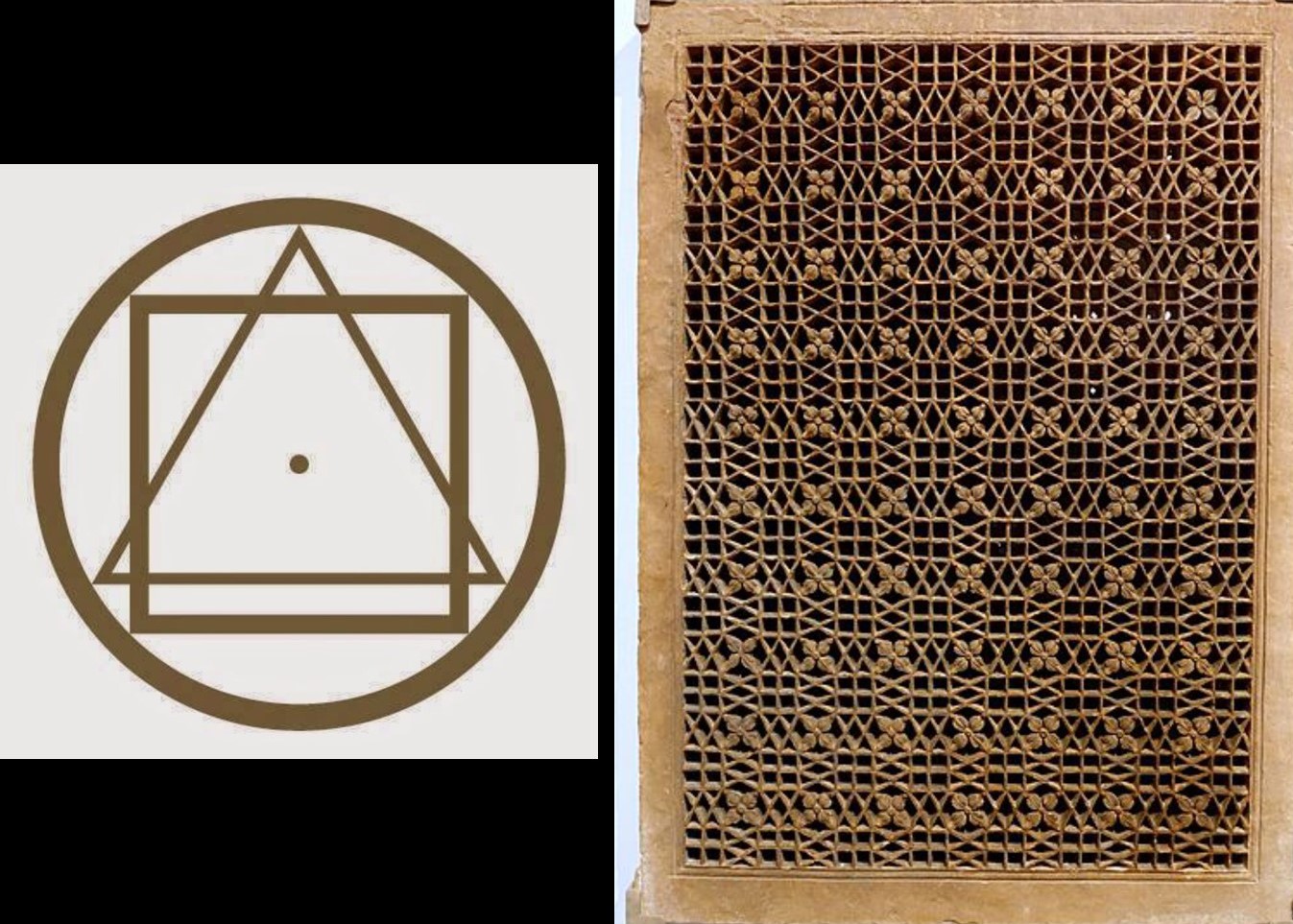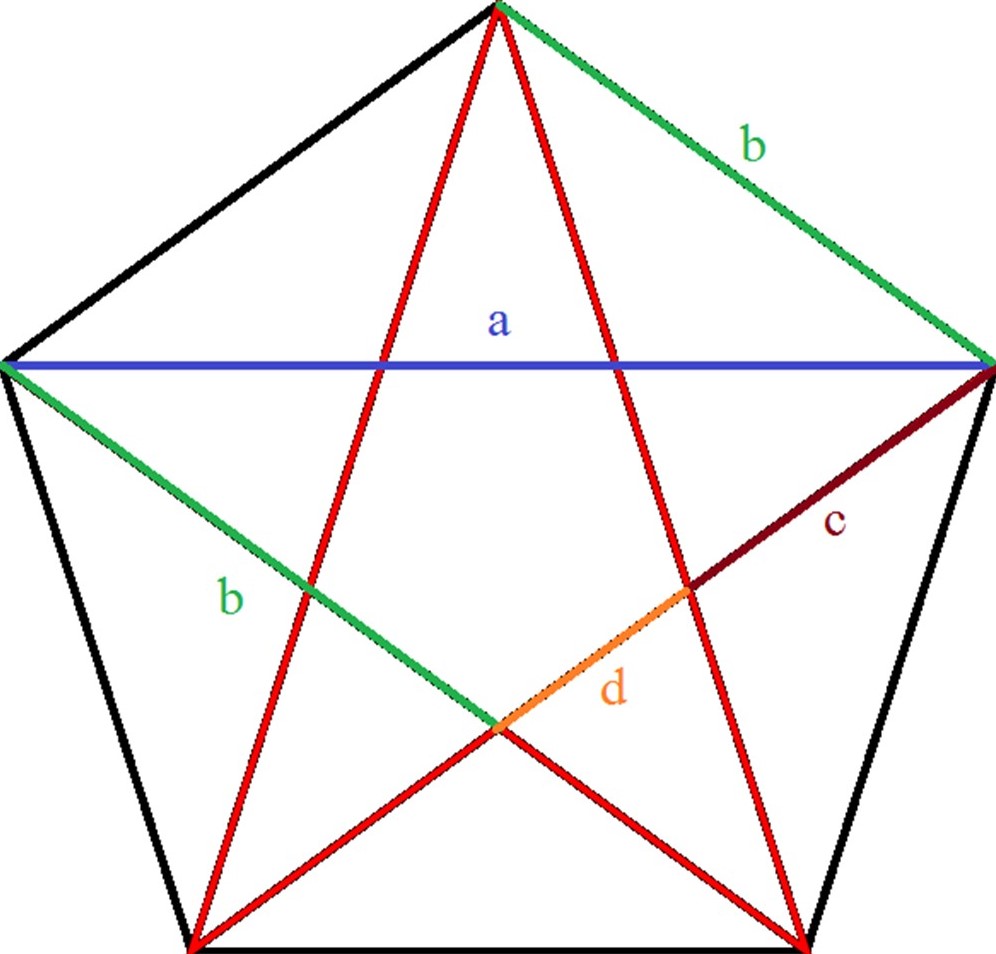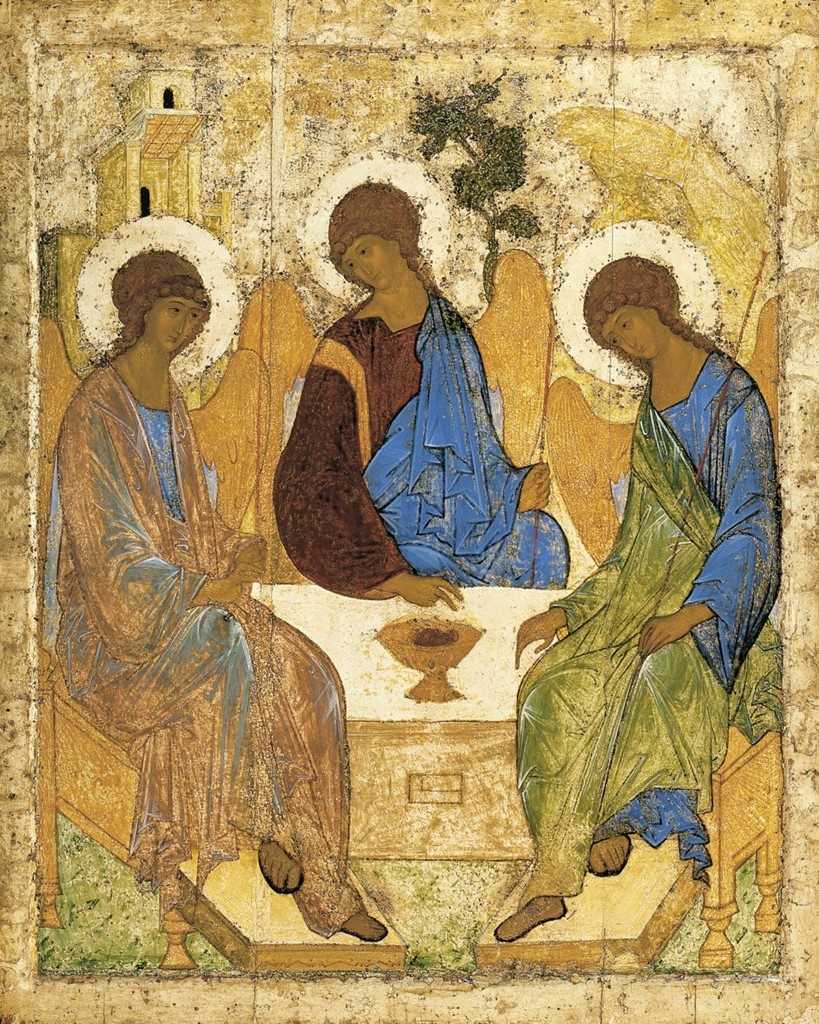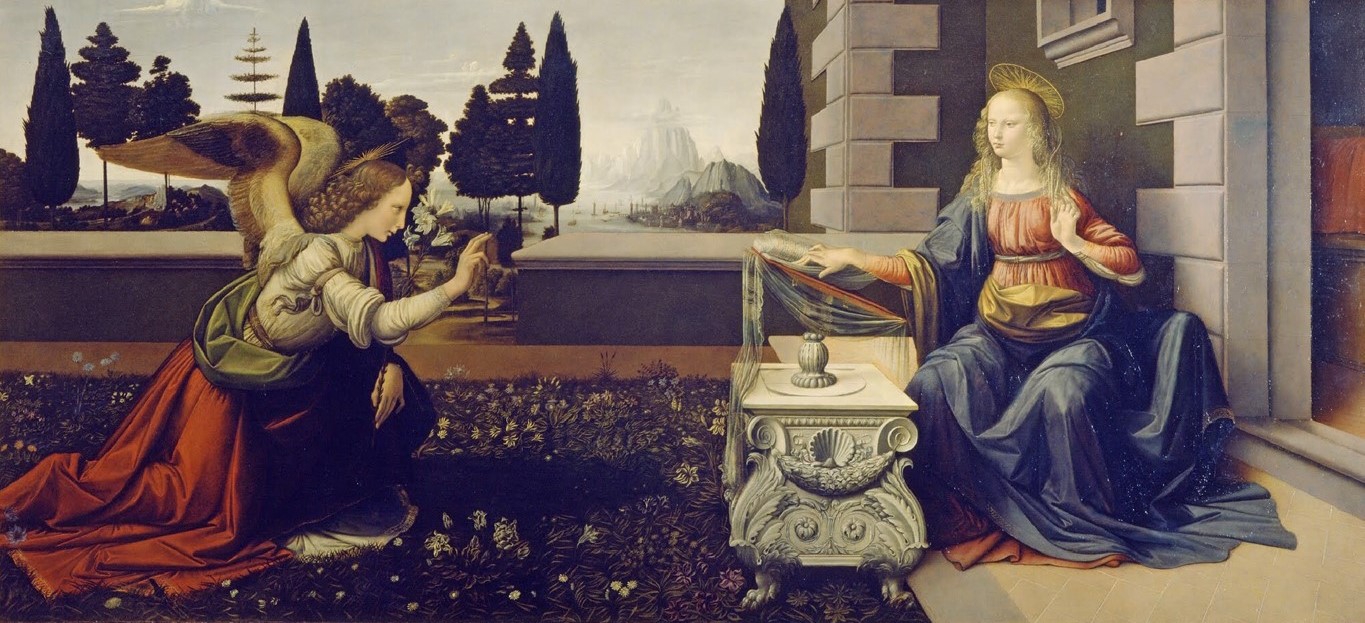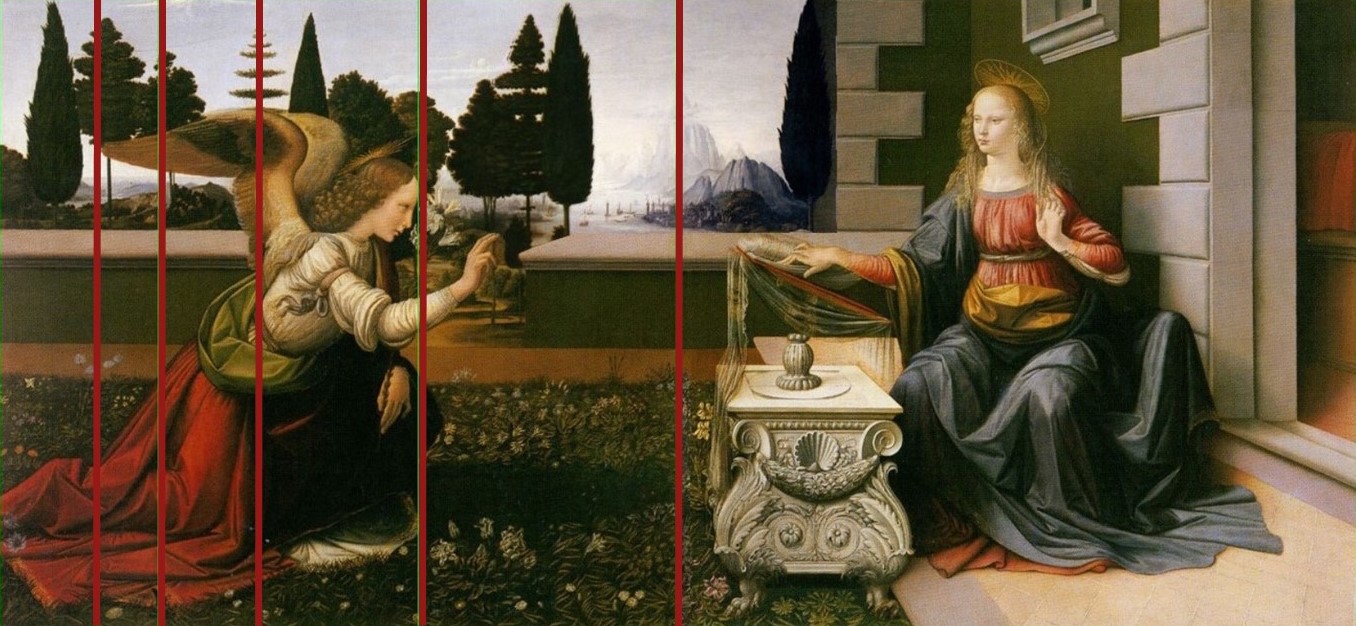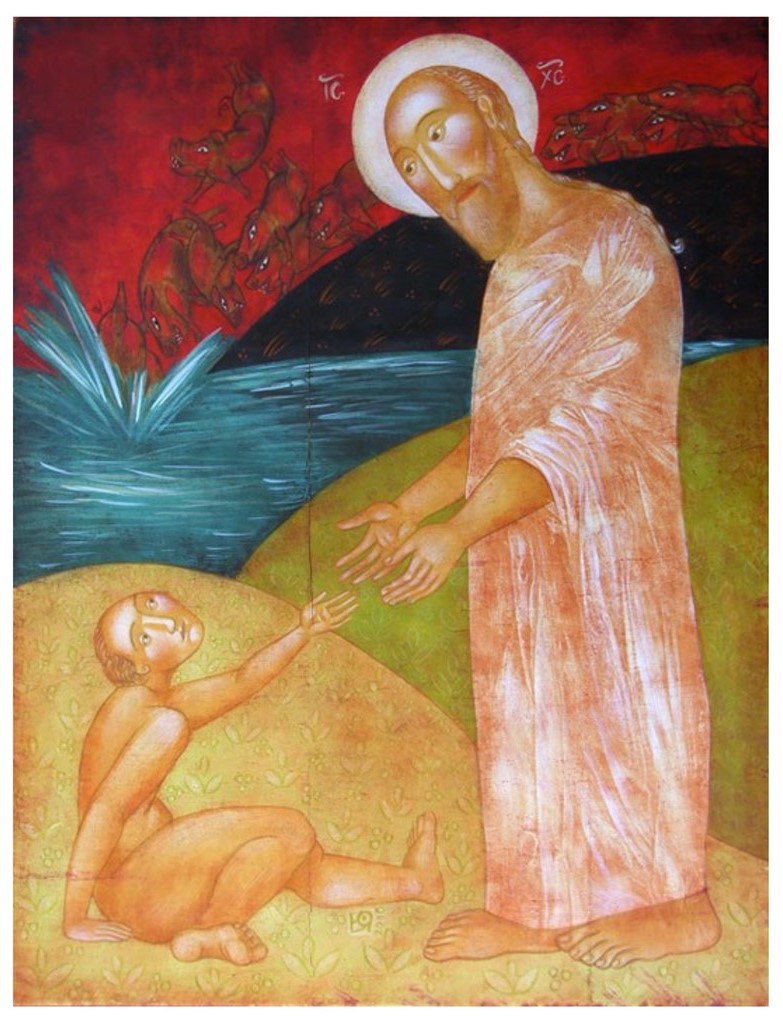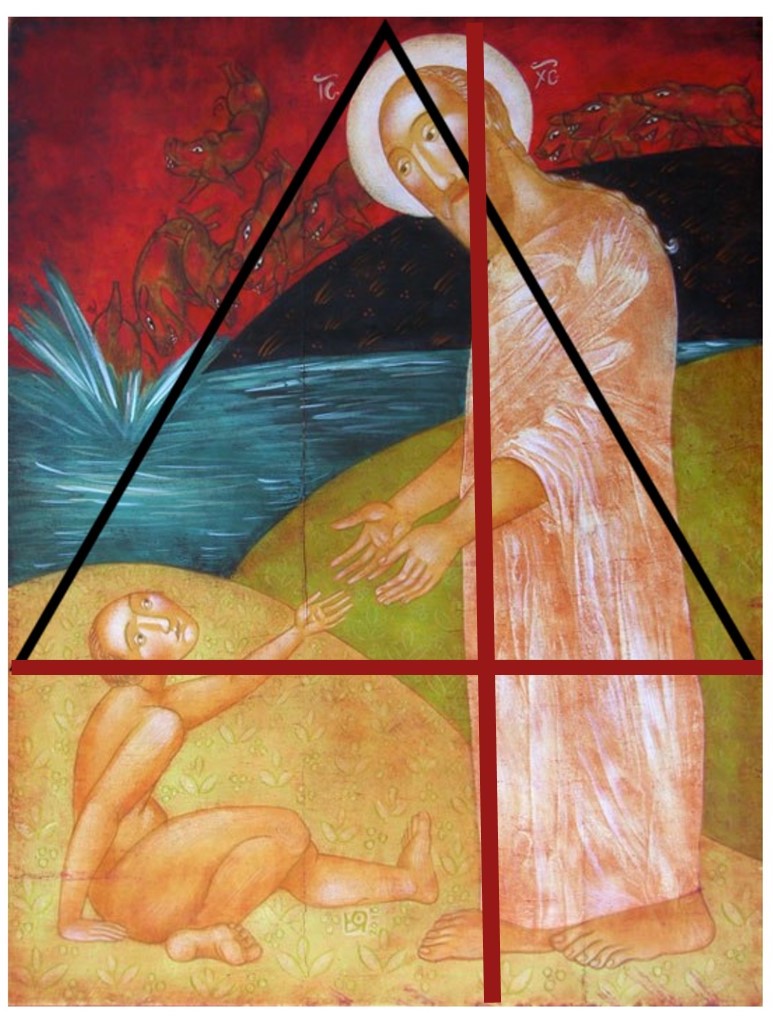Sacred Geometry in Christian Art
Sacred Geometry in Christian Art
by Sophie Hacker
This blog (first presented as a lecture at Sarum College, Salisbury, England) unravels aspects of sacred geometry and how it has inspired art and architecture for millennia. We’ll look at the basis of geometric design, how it was employed in Christian tradition and conclude with examples of contemporary practice.
But what is meant by sacred geometry? Geometry is used in so many creative areas, in architecture, video games, product design, even credit cards have been designed around a geometric ideal. But the geometry we’re concerned with tonight deepens our understanding of a God whose design of our universe is suffused with underlying, exquisite rhythms and proportions.
Humanity didn’t discover geometry, we uncovered it. In this image tribesmen are scribing a circle in the dust using an upright stick and a horizontal stick, which as it’s drawn around the base of the upright scribes a circle on the ground. ‘Geometric’ means ‘earth measure’ and this is where humanity’s connection with geometry starts.
Patterns of repetition can be seen in flowers, the fractal design of a roman cauliflower, the unfurling of a fern in spring, even the way a piece of fruit rots, they all begin with patterns in a circle. The persimmon shows a beautiful eight-pointed star centred around a circle.
So we start with that circle, a universal symbol in so many cultures and faiths of God, Infinity, Unity and Wholeness. To begin the journey into geometry, draw a line and start a new circle by placing the compass point at the intersection X. Draw a second circle to find the lozenge known in Latin as a vesica piscis (“bladder of a fish”), in Italian mandorla (“almond”).
Many early Christian and byzantine images of Christ include the mandorla, a halo that encloses his entire body, though it is significant that in this example Christ’s hand breaches the mandorla to break into the world.
By joining up the points of intersection, equilateral triangles are formed, a symbol of Trinity, with its three identical sides and angles. Equilateral triangles tesselate and also often form the basis in Islamic geometric designs, which can be seen in the next image.
Three as a significant number is found throughout both Old and New Testaments – the Ark of the Covenant contained three sacred objects (a gold jar of manna, Aaron’s staff, the stone tablets of the covenant). There were three temptations in the desert, Christ’s first miracle at Cana happened ‘on the third day’, as did the resurrection.
This image of Islamic geometry shows the tessellation of an equilateral triangle into a more complex form. Note also the rule of ‘six around one’ – a central circle around which six circles are found.
This is a powerful symbol of creation; the six days that God created being the outside circles, the inside one representing the sabbath or rest day. The six around one symbol can be easily illustrated by the use of seven wine glasses, or tennis balls, or any other circular items. Six of equal diameter will ALWAYS fit perfectly around the circumference of the seventh.
So far we have looked at the circle, a universal symbol of God, and the equilateral triangle as a Christian symbol of the Trinity. Moving from three sides to four sides we have the square, symbol of the earth, with its four corners of North, East, South and West, four seasons, four elements, four states of matter. The square is another regular tessellating shape, which is part of Islamic pattern making. This beautiful example is a 16th-century pierced sandstone screen from India. The quality of workmanship is breathtaking. The injunction not to incorporate sentient beings in Islamic art continues to inform its development even today, whilst in the church an incarnate God offers Christians opportunities to explore theology visually and in narrative art.
From the four-sided square, to the five-sided pentagon. Inside the pentagon is the pentagram. With a shape so like a human, arms outstretched, legs astride, this represents humanity. In early medieval symbolism the pentagram also represented the five wounds of Christ. The pentagon also brings us to the all-important Golden Ratio – so significant in sacred art, particularly from the Renaissance onwards. Just how ‘old’ the golden ratio is, is hotly disputed. Some historians say that Stonehenge, the Pyramid at Giza and – rather more likely – the Parthenon all show evidence of using this measurement, others suspect that to be a retrospective imposition. In the diagram shown here each line relates to every other: A is to B what B is to C and C is to D.
Here is a description of how to find the Golden Section, using only a compass and ruler. Start with line AB, draw a line BC at 90 degrees which is half the length of AB. Join AC to create line D. Put your compass point in C measured to B and scribe an arc on the diagonal D. With the compass point in A, open it to D, scribe an arc on AB, at E. E is on the Golden Section of AB, giving you AE and EB as the two useable measurements. So AE is to AB what EB is to AE. The exact ratio is 1:1.618.
The Golden Section, known as Phi, is a proportion found throughout nature, from genetic sequencing, black holes, the arrangement of flower petals and seeds, insects to the human face. It is also expressed widely through a very simple series of whole numbers, known as the Fibonacci series in which the next in the sequence is the sum of the two previous numbers. When composed as a sequence of squares and rectangles, drawn on the golden section, it provides the logarithmic spiral above, one of three main spirals found in nature. The other two are the Archimedian, which like an old vinyl record, has parallel equidistant lines, and the parabolic, which tends to define the pattern in which leaves grown on a stem. We’re going to come back to the Golden Section, but there’s one further polygon to mention, the octagon.
Fonts and baptistries are often octagonal in design. The font on the left is interesting because it echoes an important symbol in Islam called ‘Breath of the Compassionate’, a visual inhalation and exhalation, joining the elements of fire, air, water, earth and the four corners of space. In Islam there are also eight gates of heaven.
The octagon for Christians represents the new day given to humanity at Christ’s resurrection, loosening the bondage of death; eight is the number of the New Beginning. The eighth day is the traditional day for Jewish circumcision and the number of people saved on the Ark, who began a new chapter of the human story. Notice the font on the right also has a square base, rooting it in the earth, whilst the octagonal top speaks of the new beginning and the inner circle completes the sacred geometry with unity and divinity.
Architectural structures have always been dependent on successful geometry for their construction. The rules related to geometry were first written down and used in architectural design in 300 B.C. The glorious cathedrals of Europe are built using sacred geometric principles.
The stonemasons of Winchester Cathedral (above) are mapping out the stone tracery of windows in the north transept, in preparation for repairs. The whole drawing here has been completed using only a compass and rule.
These are the three rose windows and lancets of Chartres Cathedral, a building seeped in geometry, beauty, meaning and symbiology. It deserves an essay in its own right, so I won’t dwell on it now, but it helps to move along the journey to Christian art. It also shows more direct symbolic uses of geometry, as you see the one in twelve ratios, where one represents Christ and twelve are the disciples together with all the shapes included, from circles, squares and triangles.
In Chartres Cathedral the spectacular labyrinth on the nave floor is placed exactly where the rose window would be if the west front was folded down over the floor. The western rose window that depicts the life of Christ and the labyrinth both have a diameter of forty feet, evoking the symbolic use of forty in the bible as a period of testing or trial. For Moses it was forty years in the desert, forty days on mount Sinai. Jesus was tempted for forty days in the wilderness and he appeared during forty days after the resurrection, while on the fortieth day he ascended into heaven.
Once Christianity became the official religion of the Roman Empire, what had been a secretive exploration in the catacombs by gentile artisans began a rapid journey of development. In the western half of the empire one style of work emerged, which was to lead eventually to the Renaissance.
But first we look east. In the Byzantine empire, following the split of the Roman Empire when it became simply too large to govern from Rome, a very particular aesthetic developed. Previously strongly influenced by Hellenistic naturalism, this new style was more abstract.
Realistic proportions, light and color were ignored in favor of geometric simplification of forms, inverse perspective and a profound spiritual intention of offering us a ‘window into heaven’, becoming hieratic, conveying religious meaning.
The well-known example above by Rublev (completed 1425) demonstrates how sacred geometry is used in the eastern tradition. The angels entertained by Abraham in the desert are of course to be interpreted as depictions of the Trinity – with the Spirit on the right, represented by the green robe and the rock above her head. The Son is central, his hand blessing the chalice, robed in red (earthly) and blue (divine). Behind his shoulder emerges the Tree of Knowledge and the Tree of the Cross. On the left is the Father, robed in the gold of glory. He sits before the Holy City of Jerusalem. Each figure holds a red staff of authority to confirm that none takes precedence over the other, though the head of the Christ is inclined in obedience to the Father.
Here some of the geometry underlying the icon is revealed. The figures sit within an octagon, the Son and the chalice hold the central axis but reconnect to the other persons by a horizontal diameter. Three equilateral triangles are shown but there are many in the composition. Rublev also uses inverse perspective (on the dais platforms) to create a ‘space’ for the worshipper to be included in the dynamic.
This painting is separated by only a handful of decades from Rublev’s one, but they are worlds apart. In this Resurrection of Christ (completed 1465) there is attention to human proportion, musculature, perspective, foreshortening, tonal values, nature. What we see is much more a window on the recognizable world, despite the miraculous nature of the event.
Pierro Della Francesca was a consummate mathematician as well as a noted painter of the early Renaissance. There is a famous story about this fresco in the church of Sansepolcro, Tuscany. Close to the end of World War II Sansepulcro was under bombardment by the Allied Forces. A British officer, Anthony Clarke, had learned about the significance of Pierro Della Francesca during his school days at Winchester College. He persuaded his troops to cease fire, saving the church and the fresco.
Geometry offers a deeper reading of the imagery. Notice the circle – the whole of the figure of Christ is contained within it. Its edges touch the trees representing, on the left, the unredeemed fallen world before the resurrection: the trees and landscape are barren and dead. On the right, after the resurrection, the trees are in full leaf, the ground is fertile. The pentagram provides many key locations: the horizon, the top of the tomb, the flow of line through the soldiers and positioning of Christ’s body. One of many equilateral triangles connects the base of the action with the brow of Christ’s nose, lifting our eye to his steady gaze.
This extraordinary painting by Da Vinci (1472) is meant to be viewed from the lower right corner. Then the strange foreshortening of the virgin’s arm and the architectural strangeness all make sense. The technique is called anamorphosis and there is a theory that Leonardo may have developed it.
There are many golden sections to be found in the painting. The central axis is clear again, this time separating the space between the virgin and the angel, marking the different realms the two inhabit. Notice how the following golden sections fall through compositional elements – the forehead of the Angel, the stylistically different tree above the wings. Additional golden sections are located on the edges of the masonry and horizontally through several compositional elements.
Julia Stankova's The Healing of the Demon-Possessed Man is a small painting, only 40x30 cm. This is a tender depiction of Christ’s reaction to the man healed of his demons, who are sent into the pigs. After years of living homeless and naked among the tombs, here he now is, seated at Christ’s feet, clothed and sane. Christ, in receiving his thanks, commands him to return to his village and tell them about the mercy of God.
Here is added one equilateral triangle and two golden sections, showing how the golden sections divide the picture plane into specific parts. The right side holds the body of Christ, the bottom left section holds the body of the healed man. An equilateral triangle contains the most significant dialogue of hands and faces. The incline of Christ’s head mirrors the angle of the triangle, as does the splash of water as the possessed swine tumble in.
Nikola Saric was born in 1985 in Serbia. He trained in the Academy of Serbian Orthodox Church for Arts and Conservation. His work conveys the image of a transfigured world with interpretations that reflect a style that breathes and evolves with contemporary practice. Icons they are certainly not, because he makes a new language and invents compositions rather at odds with the tradition, yet they have a similar serenity.
This slide shows some of the complex geometry to be found within the design. There are many triangles, providing the structure against which the angels are depicted. Equilateral triangles spring from the top and the bottom of the outlying square, with their points located at key places in the design. A six-pointed star also hits key points. The main triangle in the design is implicit even without the lines shown.
“Art is the daughter of the Divine,” Rudolf Steiner said. There is much more to be said about this rich and complex subject, but Steiner’s quote is one way to conclude this lighting tour though a fraction of what there is to be discovered.
*******
Sophie Hacker specialises in Church Art, including stained glass windows, vestments and re-ordering liturgical space. She is a trustee of A+CE, the UK's leading organisation in the field of visual art and religion, and a Visiting Scholar at Sarum College in Salisbury Cathedral Close. Since 2006 she has been Arts and Exhibitions Consultant for Winchester Cathedral, with particular responsibility for curating three exhibitions each year. http://www.sophiehacker.com
More:
11 July 2024 / TEARS OF GOLDJonathan Evens interviews Hannah Rose Thomas
Read more...02 May 2024 / Interview with Gert Swart
28 March 2024 / Stations of the Cross in Hornsea
Matthew Askey's most recent project is a set of ‘Stations of the Cross’ for St Nicholas Church, Hornsea. This is a site-specific commission of paintings that link each Station to a part of the town.
Read more...28 February 2024 / Book review Abundantly More
01 February 2024 / James Tughan: CONTACT
13 October 2023 / David Miller Interview
“Form welcomes the formless home”
Jonathan Evens interviews David Miller on his work and the “interrelation, symbiosis and overlap” between writing and visual art
Read more...07 August 2023 / Ethnoarts Scripture Engagement
by Scott Rayl
Ethnoarts are artistic ‘languages’ that are unique to a particular community. They can help strengthen cultural and Christian identity.
Read more...12 June 2023 / Georges Rouault and André Girard
by Jonathan Evens
Rouault and Girard: Crucifixion and Resurrection, Penitence and Life Anew
Read more...28 April 2023 / Josh Tiessen: Vanitas + Viriditas
28 April - 26 May, New York gallery Rehs Contemporary will present Josh Tiessen: Vanitas and Viriditas.
Read more...10 April 2023 / Images for God the Father
by Marleen Hengelaar-Rookmaaker
How can we ever comprehend God the Father with our small human intellects? How can we ever get to know Him and learn to live with Him?
Read more...16 February 2023 / Ervin Bossanyi: A vision for unity and harmony
by Jonathan Evens
Bossanyi joined the large number of émigré artists arriving in Britain after WW II, many of whom were Jewish and explored spirituality within their work.
Read more...06 January 2023 / The Creative Process
by Colin Black
Creative journeys are full of mishaps, accidents, and wrong turnings.
Read more...01 December 2022 / ArtWay newsletter 2022
Artway will be continued by the Kirby Laing Centre for Public Theology from the beginning of 2024.
Read more...20 October 2022 / Kuyper, the Aesthetic Sphere, and Art
After three centuries of silence about art in Reformed theological circles in the Netherlands, suddenly there was Abraham Kuyper, whose great merit it was that he once again drew attention to art.
Read more...06 September 2022 / On the Street: The work of JR
by Betty Spackman
Through the project in Tehachapi JR wanted to "give voice to prisoners" and humanize their environment.
Read more...04 August 2022 / Joseph Beuys: A Spiritual German Artist
Is there a thread that connects the multifaceted work of this artist? My hypothesis is that Beuys’ spirituality is what drives his diverse work.
Read more...01 June 2022 / Interview with Belinda Scarlett
BELINDA SCARLETT, theatre costume and set designer and ecclesiastical textile artist
Interview by JONATHAN EVENS
Read more...21 April 2022 / Betty Spackman: A Creature Chronicle
When I consider the heavens, the moon and the stars that you have made, what are mere mortals that you are mindful of them… Psalm 8
Read more...08 April 2022 / Historical Models for Crosses and Crucifixes Today
All crosses and crucifixes symbolise joy and salvation. But formally there are two different types: the victorious and the suffering crucifix.
Read more...16 March 2022 / Three artworks by Walter Hayn
by Gert Swart
These three artworks must have turned Walter Hayn inside out, being so powerfully revealing.
Read more...22 February 2022 / Abstract Expressionism
by Nigel Halliday
It is worth the while to remember the deep seriousness of these artists – even if their suggested answers can look sadly thin.
Read more...07 January 2022 / Artist duo Gardner & Gardner
by Elizabeth Kwant
During COP26 artist duo Gardner & Gardner installed their work I will learn to sit with you and I will learn to listen in Glasgow Cathedral.
Read more...09 December 2021 / ArtWay Newsletter and List of Books 2021
Marleen Hengelaar-Rookmaaker intends to phase out her participation in the day to day oversight of the ArtWay website over the course of the coming new year.
Read more...03 November 2021 / The Seven Works of Mercy in Art
by Marleen Hengelaar-Rookmaaker
This overview will show that these artworks from different ages mirror the theological ideas and the charitable works of their times.
Read more...06 October 2021 / Disciplining our eyes with holy images
by Victoria Emily Jones
Images tend to work a subtle magic on us, especially after years of constant exposure.
Read more...24 August 2021 / On the Gifts of Street Art
by Jason Goroncy
These works represent an act of reclaiming public space for citizens rather than merely consumers.
Read more...27 July 2021 / Russia’s 1st Biennale of Christ-centered Art
An opportunity of dialogue between the church and contemporary art
by Viktor Barashkov
Read more...30 June 2021 / Jacques and Raïssa Maritain among the Artists
by David Lyle Jeffrey
About the influence of Jacques and Raïssa Maritain on Rouault, Chagall and Arcabas.
Read more...13 May 2021 / GOD IS...
Chaiya Art Awards 2021 Exhibition: “God Is . . .”
by Victoria Emily Jones
Read more...21 April 2021 / Photographing Religious Practice
by Jonathan Evens
The increasing prevalence of photographic series and books exploring aspects of religious practice gives witness to the return of religion in the arts.
Read more...23 March 2021 / Constanza López Schlichting: Via Crucis
Perhaps what may be different from other Stations of the Cross is that it responds to a totally free expression and each station is a painting in itself.
Read more...10 February 2021 / Gert Swart: Four Cruciforms
In a post-Christian era, contemporary Christian artists have to find new ways of evoking the power of the cross.
Read more...08 January 2021 / Reflecting on a Gauguin Masterpiece
by Alan Wilson
An artist's reflection on Impressionism, Cezanne, Van Gogh and especially Gauguin's Vision after the Sermon.
Read more...11 December 2020 / ArtWay Newsletter 2020
What makes the ArtWay platform so special is its worldwide scope thanks to its multilingual character. There are ArtWay visitors in all countries on this planet.
Read more...27 October 2020 / Art Pilgrimage
A Research Project on Art Stations of the Cross
by Lieke Wijnia
Read more...18 September 2020 / Interview with Peter Koenig
by Jonathan Evens
Koenig's practice demonstrates that the way to avoid blandness in religious art is immersion in Scripture.
Read more...17 August 2020 / BOOK REVIEW BY HEINRICH BALZ
How Other Cultures See the Bible
Christian Weber, Wie andere Kulturen die Bibel sehen. Ein Praxisbuch mit 70 Kunstwerken aus 33 Ländern.
Read more...17 July 2020 / The Calling Window by Sophie Hacker
by Jonathan Evens
In 2018 British artist Sophie Hacker was approached to design a window for Romsey Abbey to celebrate the bicentenary of the birth of Florence Nightingale.
Read more...12 June 2020 / A little leaven leavens the whole lump
From South Africa
Ydi Carstens reports on the group show ‘Unleavened’ which was opened in Stellenbosch shortly before the Covid-19 lock-down.
Read more...14 May 2020 / Jazz, Blues, and Spirituals
Republished:
Hans Rookmaaker, Jazz, Blues, and Spirituals. The Origins and Spirituality of Black Music in the United States.
Reviewed by Jonathan Evens
Read more...17 April 2020 / Andy Warhol: Catholicism, Work, Faith And Legacy
by Jonathan Evens
While Warhol’s engagement with faith was complex it touched something which was fundamental, not superficial.
Read more...25 March 2020 / Sacred Geometry in Christian Art
by Sophie Hacker
This blog unravels aspects of sacred geometry and how it has inspired art and architecture for millennia.
Read more...22 February 2020 / Between East and West
By Kaori Homma
Being in this limbo between day and night makes me question, “Where does the east end and the west start?”
Read more...15 February 2020 / Imagination at Play
by Marianne Lettieri
To deny ourselves time to laugh, be with family and friends, and fuel our passions, we get caught in what Cameron calls the “treadmill of virtuous production.”
Read more...07 December 2019 / ArtWay Newsletter 2019
An update by our editor-in-chief
and
the ArtWay List of Books 2019
16 November 2019 / Scottish Miracles and Parables Exhibition
Alan Wilson: "Can there be a renewal of Christian tradition in Scottish art, where ambitious artists create from a heartfelt faith, committed to their Lord and saviour as well as their craft?"
Read more...23 September 2019 / Dal Schindell Tribute
While Dal’s ads and sense of humour became the stuff of legends, it was his influence on the arts at Regent College in Vancouver, Canada that may be his biggest legacy.
Read more...04 September 2019 / The Aesthetics of John Calvin
Calvin stated that 'the faithful see sparks of God's glory, as it were, glittering in every created thing. The world was no doubt made, that it might be the theater of divine glory.'
Read more...31 July 2019 / The Legend of the Artist
by Beat Rink
The image of the 'divine' artist becomes so dominant that artists take their orientation from it and lead their lives accordingly.
Read more...02 July 2019 / Quotes by Tim Keller
Many “Christian art” productions are in reality just ways of pulling artists out of the world and into the Christian subculture.
Read more...08 June 2019 / The Chaiya Art Awards
by Jonathan Evens
The Chaiya Art Awards 2018 proved hugely popular, with over 450 entries and more than 2,700 exhibition visitors.
Read more...29 May 2019 / Art Stations of the Cross: Reflections
by Lieke Wynia
In its engagement with both Biblical and contemporary forms of suffering, the exhibition addressed complex topical issues without losing a sense of hope out of sight.
Read more...03 May 2019 / Marianne Lettieri: Relics Reborn
Items that show the patina of time and reveal the wear and tear of human interaction are carriers of personal and collective history.
Read more...27 April 2019 / Franciscan and Dominican Arts of Devotion
by John Skillen
This manner of prayer stirs up devotion, the soul stirring the body, and the body stirring the soul.
Read more...13 March 2019 / Makoto Fujimura and the Culture Care Movement
by Victoria Emily Jones
Culture care is a generative approach to culture that brings bouquets of flowers into a culture bereft of beauty.
Read more...08 January 2019 / Building a Portfolio of People
by Marianne Lettieri
Besides hard work in the studio, networking may be the single most important skill for a sustainable art practice.
Read more...01 December 2018 / ArtWay Newsletter December 2018
ArtWay has Special Plans for 2019!
After London, Washington D.C. and New York the city of Amsterdam in the Netherlands is now the anticipated location for a prominent art exhibition with the title Art Stations of the Cross.
Read more...11 October 2018 / The Life, Art and Legacy of Charles Eamer Kempe
Book Review by Jonathan Evens
The significance and spirituality of the work is made clear in ways which counteract the stereotype of mass production of a static style.
Read more...13 September 2018 / A Visit to the Studio of Georges Rouault
by Jim Alimena
Everything we saw and learned reinforced my picture of a great man of faith and a great artist.
Read more...09 August 2018 / With Opened Eyes: Representational Art
by Ydi Coetsee
How do we respond to the ‘lost innocence’ of representational art?
Read more...13 July 2018 / True Spirituality in the Arts
by Edith Reitsema
Living in Christ should lead us away from living with a segregated view of life, having a sacred-secular split.
Read more...17 May 2018 / Beholding Christ in African American Art
Book review by Victoria Emily Jones
One of the hallmarks of Beholding Christ is the diversity of styles, media, and denominational affiliations represented.
Read more...23 April 2018 / Short Introduction to Hans Rookmaaker
by Marleen Hengelaar-Rookmaaker
On the occasion of the establishment of the Rookmaaker Jazz Scholarship at Covenant College, Chattanooga, Tennessee, 12 March 2018
Read more...04 April 2018 / International Art Residency in India
Art for Change, a New Delhi based arts organization with a vision to see art shape society with beauty and truth, will be running its 6th annual International Artist Residency in November 2018.
Read more...15 March 2018 / The Stations of the Cross at Blackburn Cathedral
by Penny Warden
Perhaps the central challenge for the artist in imaging the body of Christ is the problem of representing the dual natures of the doctrine of the incarnation.
Read more...23 February 2018 / Between the Shadow and the Light
By Rachel Hostetter Smith
In June 2013 a group of twenty North American and African artists from six African countries met for two weeks of intensive engagement with South Africa.
Read more...01 January 2018 / Jonathan Evens writes about Central Saint Martins
Why would Central Saint Martins, a world-famous arts and design college and part of University of the Arts London, choose to show work by its graduates in a church?
Read more...06 December 2017 / ArtWay Newsletter December, 2017
ArtWay's Chairman Wim Eikelboom: "The visual arts cultivate a fresh and renewed view of deeply entrenched values. That is why ArtWay is happy to provide an online platform for art old and new."
Read more...14 November 2017 / The Moral Imagination: Art and Peacebuilding
In the context of conflict transformation the key purpose of creative expression is to provide a venue for people to tell their stories, and for their stories to be heard.
Read more...24 October 2017 / Bruce Herman: Ut pictura poesis?
For the last couple hundred of years the arts have largely been in "experimentation mode"—moving away from the humble business of craft and service toward ideas, issues, and theory.
Read more...04 October 2017 / David Jeffrey: Art and Understanding Scripture
The purpose of In the Beauty of Holiness: Art and the Bible in Western Culture is to help deepen the reader’s understanding of the magnificence of the Bible as a source for European art.
Read more...08 September 2017 / David Taylor: The Aesthetics of John Calvin
Calvin stated that 'the faithful see sparks of God's glory, as it were, glittering in every created thing. The world was no doubt made, that it might be the theater of divine glory.'
Read more...23 August 2017 / Reconstructed by Anikó Ouweneel
A much talked-about exposition in the NoordBrabants Museum in The Netherlands showed works by modern and contemporary Dutch artists inspired by traditional Catholic statues of Christ and the saints.
Read more...04 July 2017 / Pilgrimage to Venice – The Venice Biennale 2017
When I start to look at the art works, I notice a strange rift between this pleasant environment and the angst and political engagement present in the works of the artists.
Read more...24 June 2017 / Collecting as a Calling
After many years of compiling a collection of religious art, I have come to realize that collecting is a calling. I feel strongly that our collection has real value and that it is a valuable ministry.
Read more...02 June 2017 / I Believe in Contemporary Art
By Alastair Gordon
In recent years there has been a growing interest in questions of religion in contemporary art. Is it just a passing fad or signs of renewed faith in art?
Read more...04 April 2017 / Stations of the Cross - Washington, DC 2017
by Aaron Rosen
We realized that the Stations needed to speak to the acute anxiety facing so many minorities in today’s America and beyond.
Read more...07 March 2017 / Socially Engaged Art
A discussion starter by Adrienne Dengerink Chaplin
Growing dissatisfaction with an out-of-touch, elite and market driven art world has led artists to turn to socially engaged art.
Read more...01 February 2017 / Theodore Prescott: Inside Sagrada Familia
The columns resemble the trunks of trees. Gaudi conceived of the whole interior as a forest, where the nave ceiling would invoke the image of an arboreal canopy.
Read more...03 January 2017 / Steve Scott tells about his trips to Bali
In the Balinese shadow play the puppet master pulls from a repertoire of traditional tales and retells them with an emphasis on contemporary moral and spiritual lessons.
Read more...09 December 2016 / Newsletter ArtWay December 2016
Like an imitation of a good thing past, these days of darkness surely will not last. Jesus was here and he is coming again, to lead us to the festival of friends.
Read more...01 November 2016 / LAbri for Beginners
What is the role of the Christian artist? Is it not to ‘re-transcendentalise’ the transcendent, to discern what is good in culture, and to subvert what is not with a prophetic voice?
Read more...30 September 2016 / Book Review by Jonathan Evens
Jonathan Koestlé-Cate, Art and the Church: A Fractious Embrace - Ecclesiastical Encounters with Contemporary Art, Routledge, 2016.
Read more...01 September 2016 / Review: Modern art and the life of a culture
The authors say they want to help the Christian community recognize the issues raised in modern art and to do so in ways that are charitable and irenic. But I did not find them so. Their representation of Rookmaaker seems uncharitable and at times even misleading.
Read more...29 July 2016 / Victoria Emily Jones on Disciplining our Eyes
There’s nothing inherently wrong with images—creating or consuming. In fact, we need them. But we also need to beware of the propensity they have to plant themselves firmly in our minds.
Read more...30 June 2016 / Aniko Ouweneel on What is Christian Art?
Pekka Hannula challenges the spectator to search for the source of the breath we breathe, the source of what makes life worth living, the source of our longing for the victory of redemptive harmony.
Read more...09 June 2016 / Theodore Prescott: The Sagrada Familia
Sagrada Familia is a visual encyclopedia of Christian narrative and Catholic doctrine as Gaudi sought to embody the faith through images, symbols, and expressive forms.
Read more...19 May 2016 / Edward Knippers: Do Clothes make the Man?
Since the body is the one common denominator for all of humankind, why do we fear to uncover it? Why is public nudity a shock or even a personal affront?
Read more...27 April 2016 / Alexandra Harper: Culture Care
Culture Care is an invitation to create space within the local church to invest our talents, time and tithes in works that lean into the Kingdom of God as creative agents of shalom.
Read more...06 April 2016 / Jonathan Evens on Contemporary Commissions
The issue of commissioning secular artists versus artists of faith represents false division and unnecessary debate. The reality is that both have resulted in successes and failures.
Read more...12 March 2016 / Betty Spackman: Creativity and Depression
When our whole being is wired to fly outside the box, life can become a very big challenge. To carve oneself into a square peg for the square holes of society, when you are a round peg, is painful to say the least.
Read more...24 February 2016 / Jim Watkins: Augustine and the Senses
Augustine is not saying that sensual pleasure is bad, but that it is a mixed good. As his Confessions so clearly show, Augustine is painfully aware of how easily he can take something good and turn it into something bad.
Read more...11 February 2016 / H.R. Rookmaaker: Does Art Need Justification?
Art is not a religion, nor an activity relegated to a chosen few, nor a mere worldly, superfluous affair. None of these views of art does justice to the creativity with which God has endowed man.
Read more...26 January 2016 / Ned Bustard: The Bible is Not Safe
Revealed is intended to provoke surprise, even shock. It shows that the Bible is a book about ordinary people, who are not only spiritual beings, but also greedy, needy, hateful, hopeful, selfish, and sexual.
Read more...14 January 2016 / Painting by Nanias Maira from Papua New Guinea
In 2011 Wycliffe missionary Peter Brook commissioned artist Nanias Maira, who belongs to the Kwoma people group of northwestern Papua New Guinea, to paint Bible stories in the traditional style for which he is locally known.
Read more...



.JPG)
.JPG)
.JPG)
.JPG)
.JPG)
